
Developing innovation portfolios for the public sector Portfolios for public good
15 August 2018
 Alan Holden United States
Alan Holden United States John Cassidy United States
John Cassidy United States Katie Hallberg United States
Katie Hallberg United States Will Marsh United States
Will Marsh United States
Treating innovation as a portfolio of investments that balances risk and reward can help public sector organizations quantify the impact of their initiatives, justify future investments, and offset the risks presented by more transformational efforts.
Introduction
With risk and discovery at its core, innovation by nature lacks predictability. It’s impossible to fully grasp what lies at the end of a cycle of turning ideas into new solutions, or how customers will react.
Learn More
Read more from the Government and public services collection
Subscribe to receive content from the Deloitte Center for Government Insights
This tends to make managing the risks associated with innovation challenging for almost any organization, let alone one funded by taxpayers. Public sector organizations are often hesitant to invest in unproven solutions, given resource limitations, the election cycle, and a lack of the same market forces that can naturally drive innovation in the private sector.
And yet, big, risky, ambitious bets in the public sector can have tremendous payoffs. A 2011 report titled An economic engine: NIH research, employment, and the future of the medical innovation sector found that the National Institutes of Health’s research and investment generated US$68 billion in new economic activity in 2010 alone while costing the taxpayers US$26.6 billion—a single-year return on public investment in excess of 150 percent.1 Similarly, a study estimated that the Human Genome Project—an exploratory research effort focused on determining the makeup of human DNA—yielded US$796 billion from the US$3.8 billion invested over 23 years.2
Other public sector investments in innovation seem to have laid the foundation for some companies that have transformed modern life. For example, Google—a company which has helped to fundamentally change the way we engage with the world—can trace its origins not only to the work of Larry Page and Sergey Brin in a San Francisco garage, but also to investments made by the federal government. The vast majority of the US$4.5 million that funded the Stanford Integrated Digital Library Project, the assignment that initiated Google’s creation, came in the form of grants from the National Aeronautics and Space Administration (NASA) and Defense Advanced Research Projects Agency (DARPA).3
So how can a public sector organization reap the rewards of investing in truly transformational innovation efforts while mitigating the accompanying risks? The answer could lie in managing innovation as a portfolio of investments that balances risk and reward.
Innovation as a portfolio of investments
Diversification is protection against ignorance.— Warren Buffett
Diversification may be a proven method for mitigating uncertainty in financial portfolios, but the notion of diversifying investments as a key component of managing innovation likely requires a fundamental shift in the mindset of most public sector organizations—from viewing innovation efforts as isolated initiatives to seeing them as pieces of a bigger puzzle. This puzzle is the innovation portfolio.
Diversification of assets is generally one of the most important rules of investing and management. Every personal investor has been taught that a balanced financial portfolio not only includes a mix of stocks, bonds, and cash, but also emerging market funds, real estate investment trusts (REITs), and commodities. When the market is booming, an investor likely wishes that all their assets are in riskier stocks to maximize returns. But when a recession hits, those same high-performing assets are typically the first to plummet. According to investment firm Charles Schwab, “The goal of diversification is not to boost performance, rather it is to help compensate for poorly performing assets by holding others that are performing well—or at least holding up better.”4 For example, Schwab details that US$100 invested in two hypothetical portfolios in 1999—one with 100 percent stock and the other with a blend of 60 percent stock and 40 percent bonds—would have given significantly different returns in 2015. Even with a severe financial crisis in the middle, the blended portfolio would have increased by 122 percent while the stock-only portfolio would have increased by 89 percent.5
In the private sector, treating innovation as a portfolio of investments can help a company constantly make improvements to its proven “winning” products or services, while also seeking new advantages and mitigating disruptions in a structured manner.6 Google itself has famously applied this approach to making innovation investments.7
However, in the public sector there are rarely markets in which an organization is attempting to maintain an advantage, and funding streams are often decentralized across various offices or divisions. As a result, “big bets” are often managed either at the agency level or through a dedicated internal group. Meanwhile, incremental, more near-term operational innovations are often initiated and managed by the individual offices or divisions most affected by them, or by the organization’s IT office. As a result, only those public sector organizations that are deliberate in taking a portfolio-driven approach are generally able to do so.
And yet, such an approach can yield tremendous benefits. In 1999, the CIA founded In-Q-Tel to provide venture capital to startups with the potential for a substantial impact on national security. While many of its investments are not disclosed due to their relation to national security, In-Q-Tel currently features over 200 of its investments on its website, and a 2012 study concluded that the average dollar invested by In-Q-Tel attracts nine dollars of investment from other investors, helping to rapidly scale CIA R&D into the private sector to drive economic activity.8
More recently, the Smart Columbus Partnership Acceleration Fund oversaw the coordination of investments by the private and public sectors that will complement, scale, and sustain Smart Columbus projects and programs into the future. This portfolio-driven approach to smart city investments is credited with playing a significant role in the city, winning the US Department of Transportation (USDOT) the first-ever Smart City Challenge and an award of US$50 million in grant funding.9
The following are just a few examples of how taking a portfolio-driven approach to innovation can help public sector organizations more effectively:
- See the impacts of easily implemented innovations while simultaneously exploring future disruptive technologies;
- Justify taking on longer-horizon, higher-risk initiatives because they are offset by shorter-term, more certain projects;
- Manage innovation budgets and justify budget requests; and
- Ensure that innovation efforts are complementary to each other, but not redundant.
But how can a public sector organization that currently doesn’t take this type of approach to innovation move toward adopting such a model? There are multiple tools that can be used to assess a public sector organization’s innovation portfolio and achieve a healthy balance of risk and return. Each of these tools presents specific types of insights about an innovation portfolio mix to identify areas for future investment. The rest of this report will explore several models of innovation portfolio management and their application in public sector organizations.
The Ambition Matrix
One proven approach to portfolio-driven innovation management is using the Ambition Matrix.10 In their widely cited Harvard Business Review piece, “Managing your innovation portfolio,” Bansi Nagji and Geoff Tuff discuss the matrix, in which a portfolio of projects is assessed based on the “newness” of the solutions (x-axis) and markets (y-axis) they address (see figure 1).
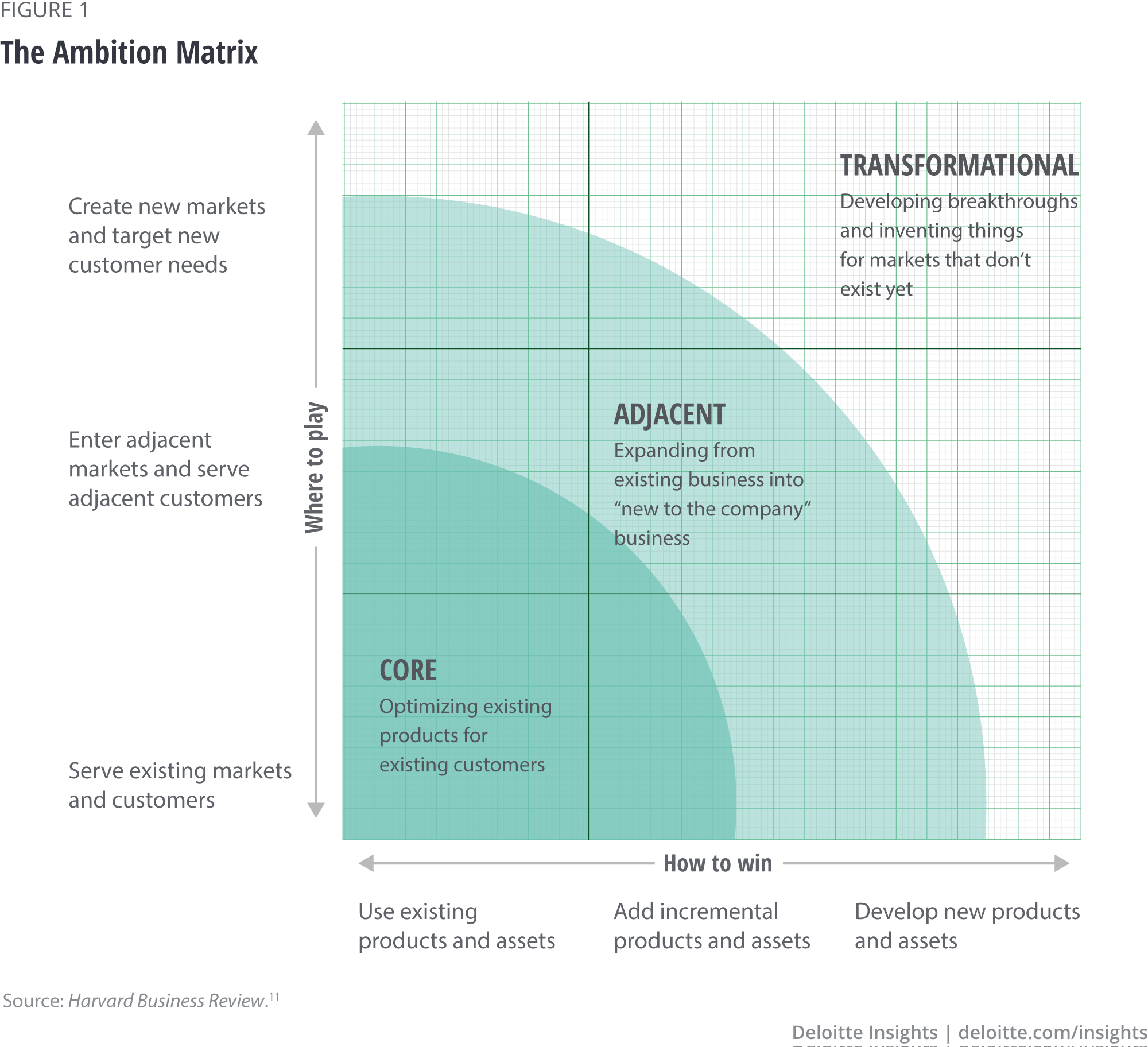
The matrix categorizes innovations as falling into one of three categories: core, adjacent, and transformational. Core innovations are incremental enhancements to existing solutions and challenge areas. It is the safest form of innovation and provides moderate returns. Adjacent innovations are existing solutions that have been enhanced or applied to new challenges. This type presents a middle level of risk and reward. Lastly, transformational innovation refers to new offerings or businesses that serve new markets or customer needs. Transformational innovation is generally the highest-risk form of innovation with the ability to offer the highest impact through the creation of differentiated new solutions. Nagji and Tuff found that while there is no one-size-fits-all approach to diversifying a portfolio, research suggests that one common successful breakdown of investments between the three types of innovation is 70-20-10—70 percent of investments in core projects, 20 percent in adjacent projects, and 10 percent in transformational. The expected returns for each type, however, is the inverse of the initial investment—10 percent of returns are from core projects, 20 percent from adjacent, and 70 percent from transformational. Organizations in a fast-paced, competitive environment (such as technology companies) may need to invest more in transformational projects to stay ahead of the curve, while organizations in a steady or heavily scrutinized industry (such as manufacturing) may need to invest more in core and adjacent projects.
In the public sector, there are no markets. However, there are groups of specific end-users with specific needs. It is therefore possible to substitute “challenge” area for “market” in the Ambition Matrix and maintain its functionality, with the most transformational innovations solving new challenges in completely new ways (see figure 2).
Consider the following two examples. In 2010, the city of Dyersburg, Tennessee, combined the processing of 311 (nonemergency information calls) with 911 (emergency calls) to simplify the user experience. CRM software opens a ticket and geo-tags each call, which is routed to the appropriate group, resulting in fewer misclassified 911 calls while still allowing for a response to emergency calls in under 10 seconds.12 While no new solution was applied and no new problem was addressed, combining the two systems still helped improve outcomes. This is clearly a “core” innovation in the public sector. Meanwhile, the US Air Force’s recent research on using falcons to hunt drones is an example of a transformational public sector innovation. To respond to the new threats posed by drones, the military is using a solution it hasn’t used before (or at least in centuries) for a military purpose.13
Just as in the private sector, public sector organizations should be investing in all three types of innovation. However, instead of market, mission should drive a public sector organization’s level of ambition and the makeup of their portfolio. For agencies in which the mission is, by its very nature, transformational (NASA projects, for example), one would expect more resources to be devoted to higher ambition levels. In mission areas such as homeland security, where agencies interact with travelers but also face emerging cross-border threats posed by new technologies, a more balanced portfolio may be appropriate.
USAID’s Bureau for Global Health is one example of a government organization that uses an Ambition Matrix portfolio framework to manage its innovation efforts (see figure 3). With over 150 innovations funded in 2018 and 25 transitioning to scale, the bureau must remain disciplined in balancing its investments in near-term solutions and more cutting-edge approaches. It invests between 70 and 90 percent of its innovation efforts in “improving the known” solutions—what could be classified as core and adjacent innovations—and 10 to 30 percent in “inventing the new” or transformational innovations. The results? An innovation presence in 33 countries and a targeted two to three million lives saved.14

Similar to the private sector, an important driver of a public sector organization’s innovation portfolio makeup is its available resources. To develop and implement core innovations, teams should be connected to day-to-day operations and have the necessary skills to develop solutions specifically tailored to the current constituents. Financial resources often come from the agency’s offices or divisions. In contrast, for transformational innovations, teams should have the time and focus to tap into latent needs as opposed to recognizable needs. Skunkworks or designated R&D groups are some examples of this. Funds can’t always be earmarked by offices or departments, and often must be allocated at the agency level to ensure adequate support for longer-horizon initiatives.
The US Department of Energy uses an approach for combining risk and time horizon to evaluate funding streams across its innovation portfolio. In its Energy Innovation Portfolio Plan for 2018–2022, the agency points out that in 2016, just over 6 percent of energy innovation funding—US$291 million—was devoted to ARPA-E, an entity established specifically to advance high-risk, revolutionary energy technologies and modeled after the Defense Advanced Research Projects Agency (DARPA). In the report, the department requests a 244 percent increase in funding for ARPA-E to devote more resources to high-risk projects, representing an effort to better balance the risk and time-horizon profile of its innovation portfolio.16
Similarly, the National Science Foundation (NSF) uses a portfolio approach to manage the approximately 50,000 proposals it receives annually for funding each year. According to its 2018–2022 strategic plan, the NSF “strives to maintain a balanced, geographically distributed portfolio of funded projects that supports different approaches to significant research questions; addresses societal needs through basic research findings and related activities; builds capacity in new and promising research areas; [and] supports high-risk proposals with potential for transformative advances in a field.”17
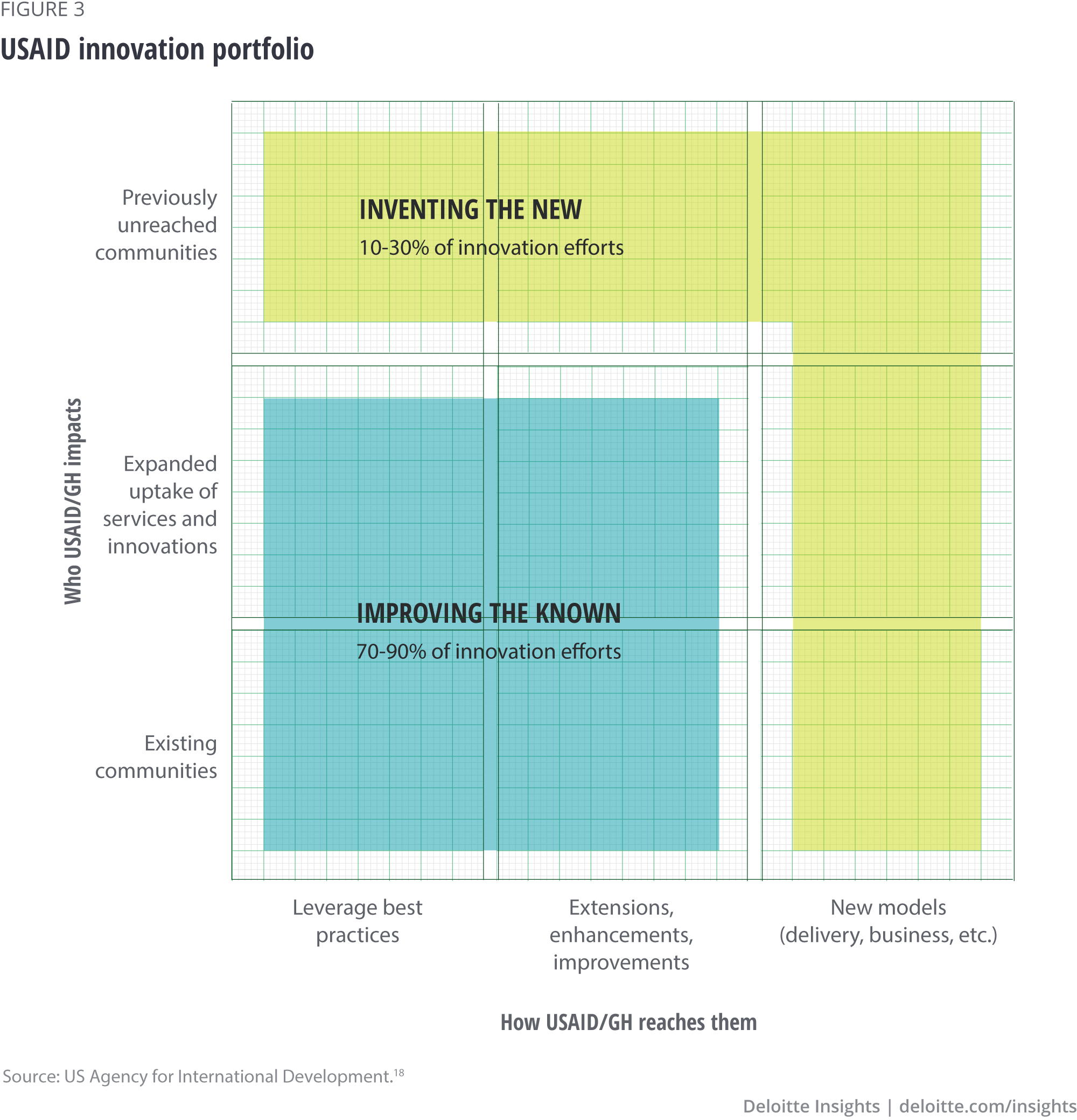
Other portfolio models
Although the Ambition Matrix is a useful framework around which a public sector organization can organize its innovation portfolio, it’s certainly not the only one.
Options portfolio model
Some portfolio models are built using a similar underlying framework as the Ambition Matrix, but with added elements of complexity and insight. For example, according to research by Ian C. MacMillan and Rita Gunther McGrath, there are five types of innovation projects, three of which would fall into the “transformational” category of the Ambition Matrix—positioning, scouting, and stepping stone options projects (see figure 4).19
In MacMillan and McGrath’s model, organizations can choose to make investments in these less certain types of projects based not merely on their relative expected likelihood of success, but also on what the organization hopes to learn from the investment.
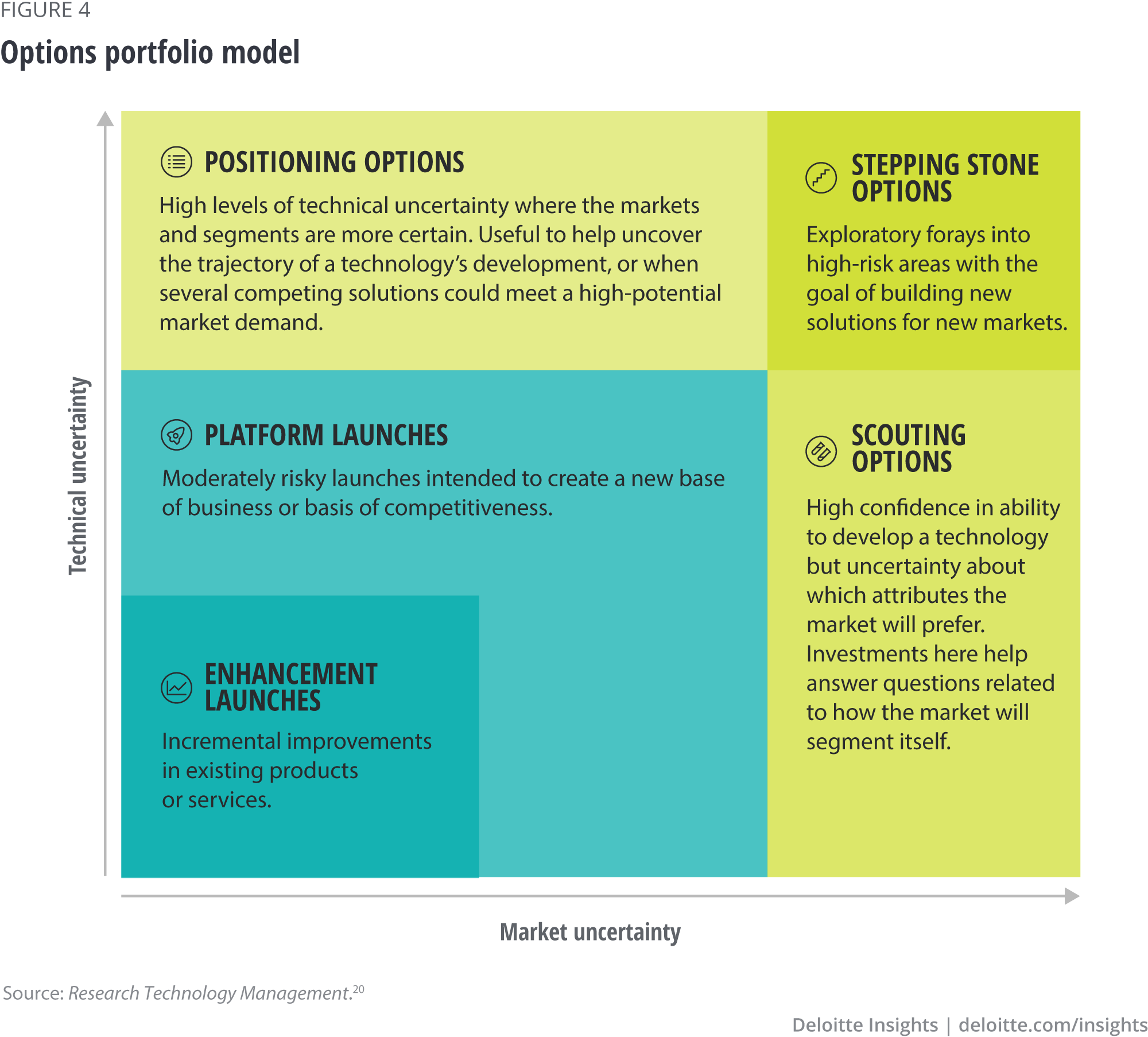
Derived from R&D technology development research, the options hold value in what they teach the organization. Positioning investments can be valuable when there is a high level of uncertainty in the organization’s ability to create a viable solution, but it has a high degree of confidence in the need to address a specific set of emerging threats or opportunities. In the private sector, positioning options are investments not merely into an uncertain solution, but also to gain information about a potential path forward for uncertain technologies and maintain market relevance. In the public sector, even if a project doesn’t achieve its original goal, a positioning project is an investment that generates knowledge that is crucial to determining the viability of certain initiatives and to decide whether further investments should be made at all.
Scouting options provide information related to the market and customer demands. In the private sector, scouting options often involve offering prototypes to early adopters to learn more about specific market needs and segments. In the private sector, investments in scouting options can help organizations obtain a sense of how an emerging trend or technology could impact their operations and engagement with end-users.
Finally, stepping-stone investments are small explorations that can lay the foundation for increasingly sophisticated challenges and provide information to inform an organization’s future innovation strategy.
The nuance of the options portfolio model is that investments can be justified based not merely on the degree of uncertainty, but on what the organization is hoping to learn from a given innovation investment. This can allow an organization to shift an even greater number of resources to less-certain efforts, as the value they provide extends beyond the ROI of the solution itself to include knowledge gained that can be applied moving forward.
Impact-feasibility portfolio model
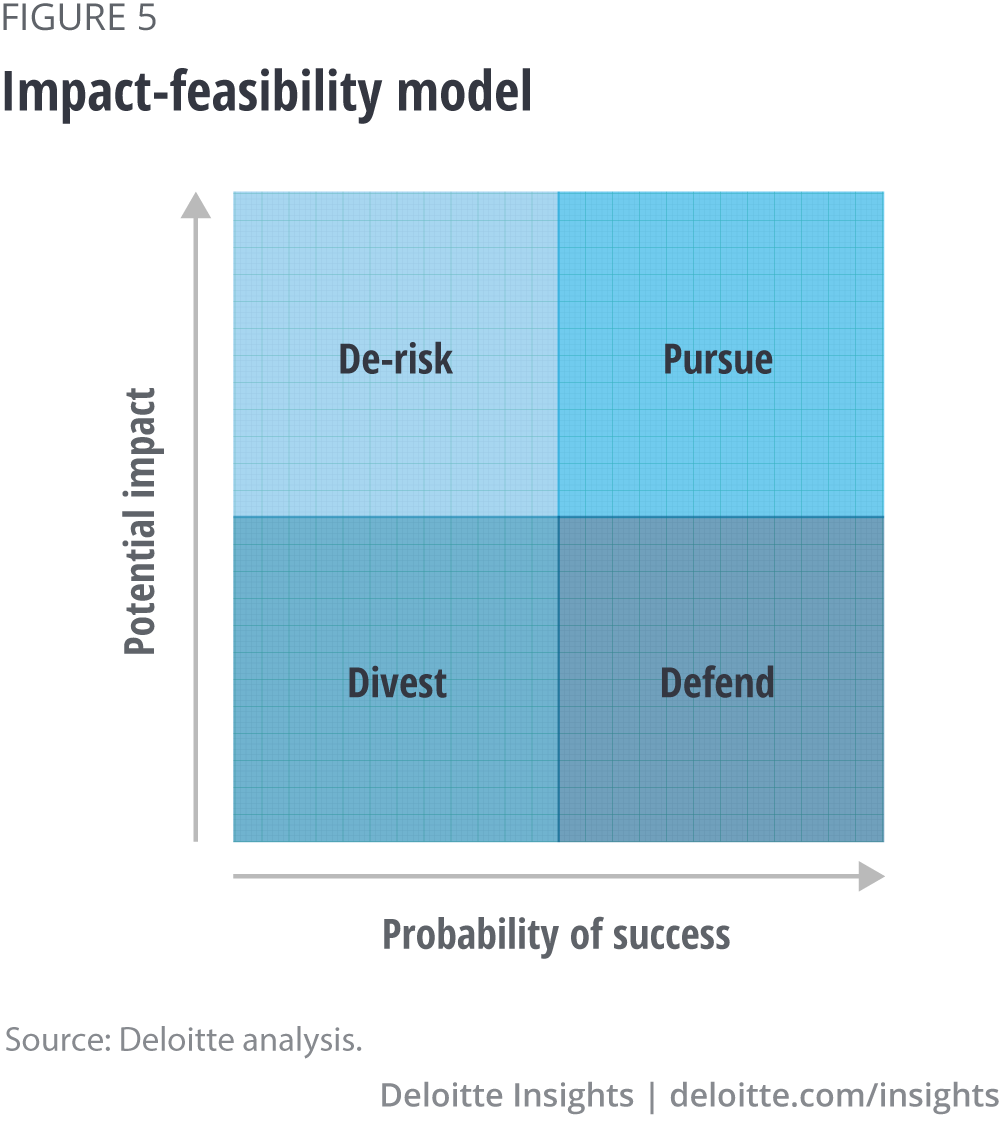
A second alternative for organizing an innovation portfolio is by focusing primarily on return on investment. In this model, an organization selects a combination of innovation initiatives based on their potential overall impact and probability of success, and then continually evaluates its portfolio using return-on-investment analyses (see figure 5). A potential advantage of such a model is that it forces an actual assessment of viability and impact, rather than merely relying on the “newness” of a problem area and solution as the Ambition Matrix does.
In its plan to invest US$1.7 billion toward improving the US education system over the next five years, the Gates Foundation takes a portfolio approach to innovation that blends elements of the Ambition Matrix and a more functionally based model. In an October 2017 speech, Bill Gates described how he plans to designate 25 percent of the funding to big bets or innovations “with the potential to change the trajectory of public education over the next 10 to 15 years.” These could include research, technology applications, or “promising developments in neuroscience, cognitive psychology, and behavioral economics.” Fifteen percent of the funds would go to charter schools and the remaining 60 percent would be devoted to developing “networks” of schools that could partner to share data and jointly serve the children’s needs.21
USAID’s work to improve access to injectable antibiotics in developing countries is another example. The group conducted a bottleneck analysis for Ethiopia, Nigeria, and Uganda to identify barriers to access and prioritize potential solutions (see figure 6). These analyses have made it easier to chart a pathway to scale and agree as a global group on where to focus resources.22
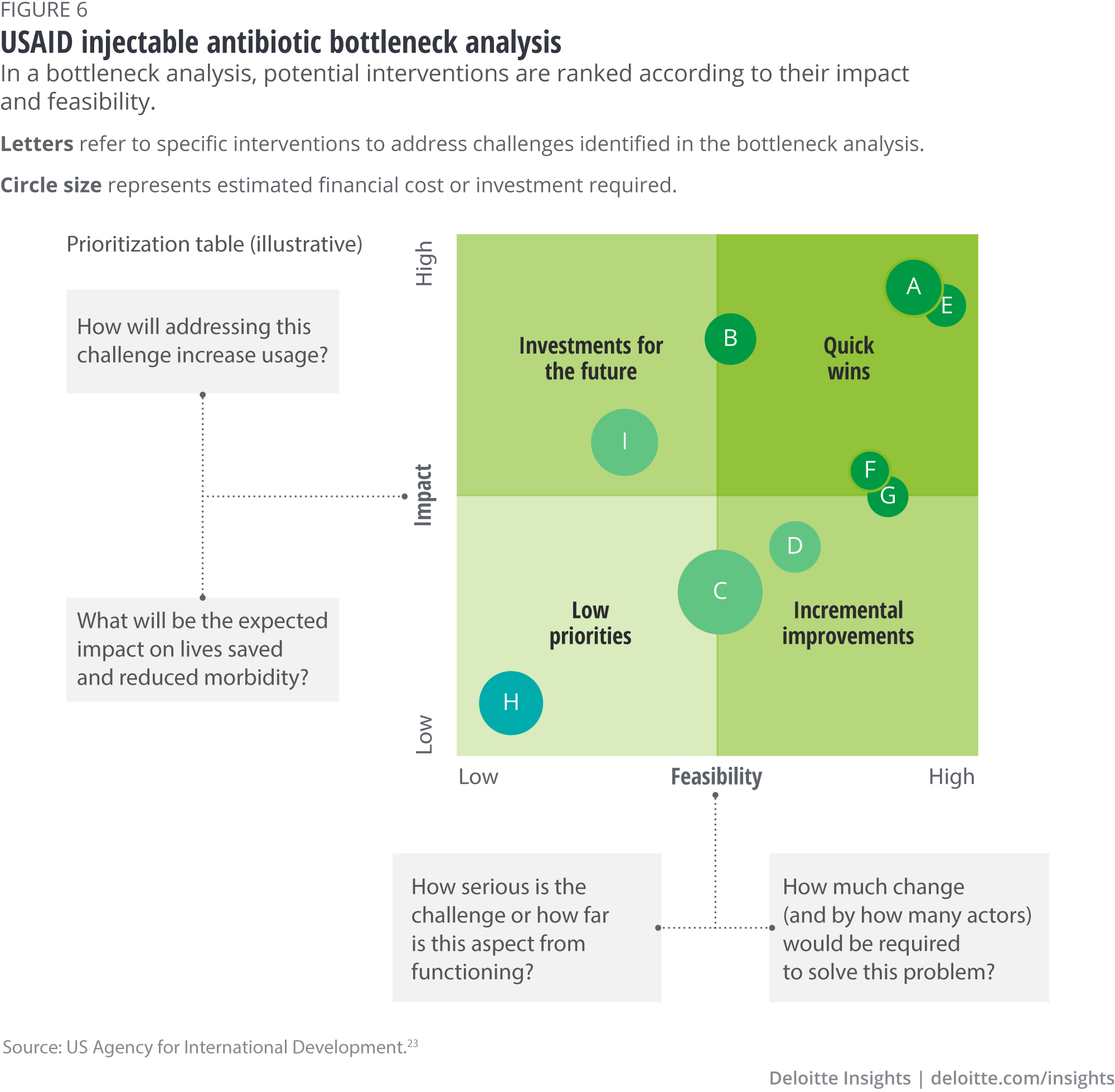
Innovation life cycle portfolio model
A third alternative is to organize an innovation portfolio around the innovation life cycle itself. Ideally, innovation should function as a funnel, with each successive stage of the innovation process filtering out unsuccessful solution concepts until only the best are scaled. In the public sector, many organizations lack the resources to develop, pilot, and scale an infinite number of good ideas. These organizations must therefore often assign resources to support each of these phases. These resource constraints can actually allow an organization to select a portfolio of projects based on maximizing the throughput of the funnel. Imagine that an organization has the resources to scale two solutions over the course of six months. In a year, it should therefore only scale four solutions. By investing in a “balanced” portfolio of projects based on their maturity in the innovation life cycle, the organization can maximize the use of its resources and ensure that it has the right number of solutions in development across each phase. (See figure 7.)
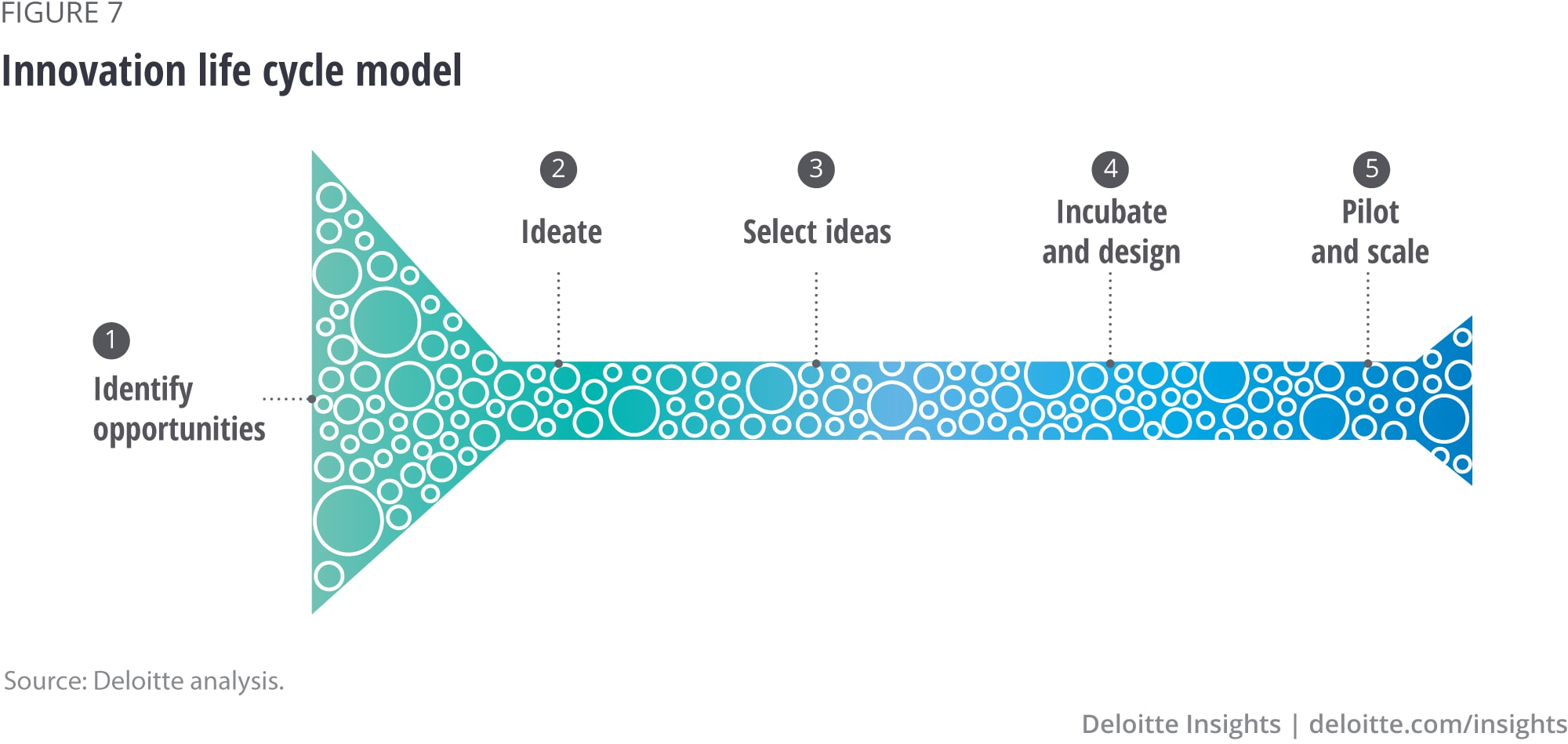
The Centers for Medicare and Medicaid Innovation (CMMI) applies a rigorous process to ensure that its portfolio of innovation investments is balanced across the development stages of the innovation life cycle. CMMI has launched a Pioneer Accountable Care Organization (ACO) that invites proposals for innovative payment models from providers to provide better care for beneficiaries. After a rigorous review process, a select group of these ACOs is given 18 months to implement its ideas on a small scale, after which they are evaluated on both claims data and quality measures. At the end of the pilot phase, the most effective solutions are scaled for broader use. The strict timelines and evaluation structures CMMI uses allow the organization to manage its pipeline across the innovation life cycle in a strategic, rigorous manner.24
Regardless of which framework is used, what ultimately tends to differentiate a portfolio approach from a simple stage-gate or go/no-go analysis is the fact that in a portfolio approach, potential innovation investments are compared with each other. Rather than simply establishing a threshold for impact that makes an innovation worth investing in, a portfolio approach assumes that too few, or too many, innovation concepts could “make the cut,” and therefore choices need to be made among them. Relying on simple comparisons of expected ROI may result in an organization missing out on truly transformational opportunities with low likelihood of success, or incremental opportunities that can generate momentum and stakeholder buy-in for future innovation efforts.
Additionally, it is important to remember that these portfolio models are not mutually exclusive and do not have to be used in isolation. Each can provide valuable perspective on an organization’s innovation efforts, and when used together can provide powerful insights to improve innovation performance.
First steps toward a portfolio approach
So how can a public sector leader begin to move the organization toward a portfolio-driven approach to innovation? The following steps can provide a tactical starting point:
- Inventory your innovation efforts. While it may seem like an obvious step, many organizations do not document key details about all of their innovation investments in one place. Some key elements that could be captured to inform portfolio development include: (1) phase of the innovation life cycle the initiative falls in; (2) problem area the innovation is attempting to address; (3) expected and/or realized impact of the innovation to date; (4) expected and/or realized cost of the innovation to date; and (5) location of deployment if in pilot or scaling phases.
- Assess the innovation efforts based on selected model criteria. For example, if using the Ambition Matrix, score each existing innovation based on the “newness” of the solution and the challenge it is solving, with “1” being the least new and “3” being the most new. For public sector organizations, an easy way to determine the score is to think of each dimension in the following way:
- Solution: A 1-rated solution is one that is already being used by the organization on a similar or the same problem. A 2-rated solution is one that is already being used by the organization, but on a different area or different problem. And a 3-rated solution is one that is completely new to the organization.
- Challenge: A 1-rated challenge is one that already exists and is already being addressed by a different solution. A 2-rated challenge is one that has existed, but has never been directly addressed. And a 3-rated one is a new challenge that has never been addressed.
Similar scoring can be conducted regardless of whether you are using an options, impact-feasibility, or life cycle model.
- Map and assess your current portfolio. Using the scoring process described above, plot your existing projects across whatever framework you have selected. Add up the budget and resource allocations of your current portfolio, and compare them. Is the resulting distribution of funding and resources representative of what you would hope for? For example, if using the Ambition Matrix, do you have some big bets on transformational efforts and some sure-thing investments to solve existing problems? If using the life cycle model, do you have a steady stream of resources across each phase to prevent bottlenecks or idle resources?
- Set budgets for each type of innovation. As explained previously, in the portfolio approach, potential innovation investments are compared with each other for funding, though only with others of the same type. So, if using the Ambition Matrix, transformational projects are compared only with other transformational projects, and so on. In the options model, stepping stones are only compared to other stepping stones. And in the life cycle model, only innovations ready to be piloted would be compared to others in the pilot phase. It is therefore important to identify the resources devoted to each tier of innovation.
- Scope innovation channels to support your desired portfolio mix. Once you’ve identified a desired breakdown for your portfolio by resource allocation, you can begin designing the channels you’ll use to generate ideas to fulfill that portfolio vision. For example, internally focused innovation efforts tend to generate more core and adjacent solutions, since they are driven by people who know the organization and its problems but are also biased because of institutional norms. External ideation can be more transformational, but less easily implemented. Challenges and crowdsourcing can generate more ideas, while a workshop may result in fewer but more built-out solutions. The nature of the constraints you place on an effort can also shape the nature of the solution. For example, challenging questions that ask for solutions that can be implemented in three to six months could naturally yield more core and adjacent solutions than transformational solutions.
Conclusion
For far too many public sector organizations, innovation can seem like a series of one-off activities that are exciting but undisciplined, a fun side activity at best and a buzzword at worst. But investing in innovation can have a tremendous impact on a public sector mission, simultaneously demonstrating short-term, immediate impact and positioning an organization to respond to future disruption. The key to this, however, is managing innovation in a disciplined way that balances risk and return. A portfolio approach can help achieve this balance.
© 2021. See Terms of Use for more information.




